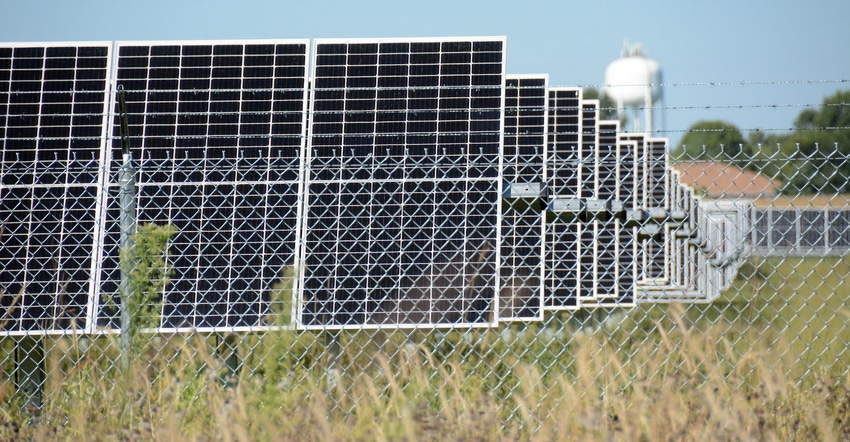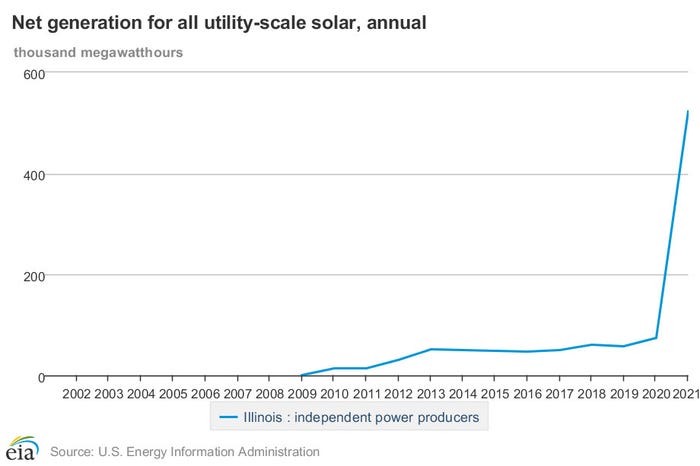September 12, 2022

When I was growing up, a favorite pastime for many teenagers in my hometown in rural Illinois — newly acquired driver’s license in hand — was to head to Charleston and drive back and forth down Lincoln Avenue, checking out and meeting up with all the other teenagers doing the same. We enjoyed the freedom that came with this rite of passage into young adulthood.
My family didn’t live in Charleston, so I’d hop into my ’76 Vega and head into town. Except for Blackie’s memorial, the drive over was a vista of corn and soybeans through some of the most fertile farm ground in the world.
Today, that view is interrupted with rows upon rows of solar panels that make up the 1,600-acre, 200-megawatt Prairie Wolf Solar Farm developed between Ashmore and Kansas. Solar development on prime farmland has exploded in Illinois.
Its growth was spurred on in part by the passage of the Illinois Climate and Equitable Jobs Act, signed into law by Gov. J.B. Pritzker in September 2021. This comprehensive bill outlines power sector decarbonization by 2045, creates equitable clean-energy workforce development pathways and expands state commitments to energy efficiency, renewable energy and electric vehicles.
According to the U.S. Energy Information Administration, megawatt production from independent power producers jumped from just under 75,000 megawatts in 2020 to over 523,000 megawatts in 2021.
Further, the Solar Energy Industries Association anticipates that solar capacity in Illinois is expected to grow 3,712 megawatts, or more than 1,700%, over the next five years.

Where are all these solar panels going to go? Many will go on prime Illinois farm ground.
The Illinois Society of Farm Managers and Rural Appraisers does not have a formal position on solar development. Members will tell you there is always concern when productive soil is lost, but at the same time, many would argue that landowners should have the freedom to do what they want with their land, within reason. Loosely fettered land ownership is one of the fundamental rights that makes this nation great.
You may ask, if all these solar farms are going to be built, how will that affect my farm’s values?
Lessons from the East
Last month, the American Society of Farm Managers and Rural Appraisers hosted a webinar, “Solar’s Impacts on Rural Property Values.” ASFMRA member-appraisers Rich Kirkland from North Carolina and Don Fisher from New York shared their experiences appraising property near solar developments. Their markets are further along in the development of solar energy than we are here in Illinois.
In these types of projects, appraisers look for factors that increase external obsolescence. External obsolescence is described as a form of depreciation caused by factors not on the property itself, such as economic, social or environmental.
Both appraisers discussed different categories where external obsolescence occurs. The ones considered among the more negligible for solar are potential hazardous materials in the panels, odor, noise and traffic. U.S. EPA has done substantial studies on solar projects, and its findings are that the developments bring little impact on the local environment. Once built, the developments are largely static and produce little to no odor, noise or traffic.
Other concerns the appraisers spent more time looking at were stigma and undesirable viewshed or diminished views from the property. Often when a development is initiated, neighboring landowners who may like solar projects in general find they don’t like them next to their property. In the industry, these protesters are described as NIMBY: Not In My Back Yard.
Land values
Kirkland and Fisher found that when appraisers were surveyed in areas where solar projects have gone in, the difference in the range of valuation ran from down 25% to up 10% when compared to properties not within the immediate area of the project. When that survey was further filtered and separated by those appraisers who actually conducted appraisals for properties near solar developments, they found that the appraisers who did not appraise nearby came in with lower anticipated valuations when compared to the appraisers who actually did a nearby appraisal. That indicates that the expectation of lower valuations did not hold true when properties actually sold.
And how about the view? Kirkland and Fisher’s studies indicated that when there were adequate setback requirements and vegetation planted to block the views, impact on local land values was negligible to positive.
So, if Illinois values follow the trends we see in areas of the nation with more solar development, we may lament the loss of productive ground — but we can be assured that the value of our own farms nearby should not be affected.
Lauher owns Rolling Acres Ag Solutions and is a member of the Illinois Society of Professional Farm Managers and Rural Appraisers. Email questions to [email protected]. The opinions of this writer are not necessarily those of Farm Progress/Informa.
Read more about:
SolarYou May Also Like




